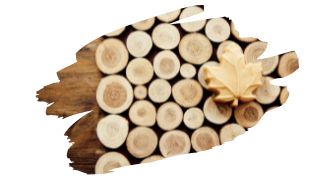Sugar Maple is better known for giving us great tasting Maple Syrup. But, who says that this tree can’t also be a great source of firewood?
Not us, that’s for sure! You see, great firewood needs to be fairly dense, enough so that it can burn long and hot for a while. And Sugar Maple, (also known as Hard Maple), can produce a lot of heat.
But, is Sugar Maple really a good clean burning firewood?
Well, in this post, you’ll find out what you should check for when it comes to choosing clean burning firewood. You’ll also discover exactly how much energy burning Sugar Maple wood can produce.
And keep reading to find out why Sugar Maple wood makes for fantastic firewood…

This post may contain affiliate links to products that we receive a commission for (at no additional cost to you). Learn more here.
What Type Of Wood Generally Burns The Cleanest?
Good firewood should be dry, first and foremost. After that, it should contain very little tree pitch or sap. And last, but not least, it should not come from a poisonous or otherwise toxic tree species.
Now, when it comes to heat, you will also need firewood to be fairly dense. That is because dense wood burns longer and hotter.
So, with all of this in mind, dense hardwoods like White Oak and Birch wood both make for fantastic firewood.
Related Post: Is Mulberry Tree Wood Good For Firewood?
What About Smoke? How Do You Minimize Smoke Emissions?
When firewood produces a lot of smoke, it is because there is a lot of moisture in that log.
The fire burns the moisture, turning it into steam. And that excessive steam thickens up the smoke. If you want to minimize thick lung clogging smoke emissions, then you need to minimize the moisture content inside firewood.
Now, the way you do this is by allowing firewood to dry before burning it. This is called seasoning wood, and it can involves leaving firewood to dry for a few months.
Related Post: How To Season Wood (7 Tips)
And What Kind Of Wood Should Not Be Burned In A Fireplace?
Avoid using wood from poisonous trees as firewood. The reason for this is simple; the poisonous compounds in those trees can collect in the smoke, fumes, and soot. And those toxic compounds are far too dangerous to have collecting in your home.
In addition to this, you should also avoid using wood that has a lot of sap or tree pitch in it. This is because these wood types, (such as Cedar and Pine), pose a fire hazard if they are burned in a fireplace with a chimney.
Tree pitch/sap are thick resinous substances that can collect in the soot lining a chimney flue. This can cause chimneys to become backed up, and that can lead to chimney fires.
Related Post: Can You Safely Burn Camphor Wood In A Fireplace?
OK. So What About Sugar Maple Wood? Is It Safe To Burn In An Indoor Fireplace?
Well, you already know Sugar Maple as being famous for producing sweet edible syrup. But what you may not know, is that when it comes to firewood, Sugar Maple wood is ideal.
Sugar Maple lumber not toxic to humans, so it can be safely burned in an indoor fireplace.
And although this tree produces a lot of tree sap, that sap is very watery — and is a world away from the thick resinous sap you’d find saturating trees such as Cedar and Pine. So, you can burn this hardwood in a fireplace with a chimney.
Nonetheless, the one big criteria that makes Sugar Maple fantastic option for firewood is in the heat if produces.
This particular Maple species produces a fair amount of heat, thanks to its incredible tough density. In fact, it can burn hot for a good long while.
And How Much Heat Does Sugar Maple Produce?
Well, the BTU (British Thermal Unit) rating of wood reflects the amount of heat generated by burning wood.
The BTU measures the amount of energy it takes for fire to consume a piece of material. The more energy it takes, the longer that firewood will burn. And this in turn leads to more heat for your home.
Low BTU firewoods don’t burn for very long, and are little more than good kindling — and are certainly not good sources of fuel.
However, when it comes to Sugar Maple, this hardwood has a BTU of 24.0.
This places Sugar Maple only a touch under White Oaks 25.7 BTU rating. And Sugar Maple even beats out Birch woods 23.6 BTU rating!
So, as long as you give Sugar Maple firewood plenty of time to season, then feel free to use it as a source of fuel.
And How Long Does It Take For Sugar Maple To Season?
It takes 6 to 12 months for Sugar Maple woods moisture content to fall to low enough levels for it to be used as firewood.
You see, when wood is first logged, it has a moisture content of around 100%. But, you need to get that moisture content level down to 20% (or lower) before its ready for your fireplace.
You can accurately check the moisture content of firewood by using a device called a Moisture Meter.

Or, you can go the old school way, and manually check the amount of moisture in firewood yourself.
And how do you do this? Well, all you need to do is burn a single small piece of your stack of firewood. If a tiny piece of wood smokes up a storm, then the rest of that pile needs more time to dry.
To Wrap Up, Here Are The 3 Key Takeaways From This Post…
- 1). Good firewood should be dry. This involves seasoning wood, and it is the best way to keep firewood smoke emissions to a minimum.
- 2). Firewood should also be fairly dense, so that it burns for a good long while. This will let you get the most heat from this fuel source.
- 3). Sugar Maple is a fantastic choice for firewood. It is a dense clean burning hardwood, that is safe to use in an indoor fireplace.
References:
Wood Heating | Forestry.usu.edu
Wood Smoke Awareness | EPA.gov



